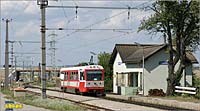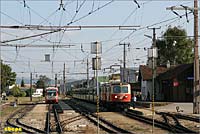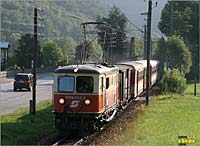| |
After
a few kilometers the line passes Nadelbach. Because of the close distance
to St. Poelten, there is no station. This is train 6845, called the
colorful train, because of the special painting of the carriages. |
|
|
|
|
| |
After
about 6 km trains arrive at the Schwadorf station. In the background
the junction with the highway A1 between Vienna and Salzburg is visible.
A class 5090 railcar stops.
(top of page). |
|
|
|
|
| |
The
line now enters some hilly countryside. It interrupts the straight
track construction for some few kilometers. The train is passing the
Matzersdorfer bridge. In the background the mountains are visible,
which are line destination after about 85 km (~53 miles). |
|
|
|
|
| |
Just
a close distance later this image was shot. The composition consists
of a motor unit 4090, a steering unit 6090 and a middle coach 7090.
Another
train consisting of 2x4090 and 2x7090 was not in operation during
my 2003 photo shootings.
|
|
|
|
|
| |
When
arriving at the Pielach valley after about 10 km, the line again continues
very straight. An old stile telegraph line which is still in operation,
is running adjacently to the rail track.
(top of page). |
|
|
|
|
| |
At line kilometer 12 the Ober Grafendorf station gets approached.
Here the branch line to Wieselburg starts. In the middle a special
train of a Mariazell railroad fan club and left the railcar to Wieselburg
is visible. On the main line 1099 locos are in twin operation from
8 carriages upwards. |
|
|
|
|
| |
Guided
by the Pielach river the line continues, passing the Kammerhof station
after about 18 km. Countryside starts getting hilly again. |
|
|
|
|
| |
Behind
the Hofstetten Gruenau station the line enters some few kilometers
of newly constructed rail track. Danger zones of two highway junctions
were terminated with this new construction in 1998. Image with train
on the new construction. (top of page). |
|
|
|
|





















